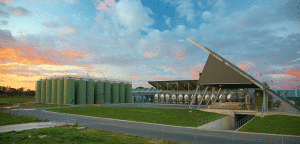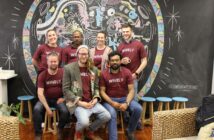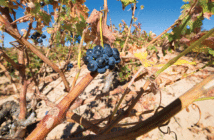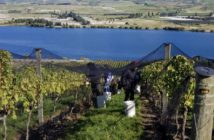
Oxford Landing Estate Vineyard and Winery sits on land where drovers once grazed and watered sheep.
Oxford Landing Estate Vineyard and Winery sits on land where drovers once grazed and watered sheep. Today it’s home to a loyal flock of down-to-earth folk who take great pride in making quality wines, enjoyed the world over.
With 650 acres under vine on the northern edge of the Barossa Valley, Oxford is not exactly small, but by micro-managing 130 five-acre blocks as separate ecosystems, the grapes are given exactly what they need to achieve optimum flavour.
Techniques such as detailed pruning, canopy management and crop thinning provide the winery with ultimate control in expressing the individuality of each block. Oxford prides itself on being nimble enough to harvest small batches of the fruit as soon as they ripen, so not an ounce of freshness is lost.
However, the key to Oxford’s success is its ability to achieve a continuous production flow via a sophisticated automation and control system. In winemaking, this timing is particularly crucial, since the grapes need to be processed within a critical window of time where the acid and sugar content are at a premium.
To achieve this, together with keeping up with increasing consumer demands, winemakers in Australia and New Zealand are turning to technology to streamline the process.
One of the main challenges with winemaking is that customers expect consistency, they get used to a particular label and expect it to taste the same, but every year the acid level and sugar levels are different, as are the aromas and colour of the berries.
When demand for Yalumba wine varieties exceeded land capacity, Oxford was established as the primary producer of the label’s popular two-litre cask wine varieties. Winery operations manager John Ide says the aim for Oxford was “an environmentally friendly plant incorporating the latest in winemaking technology, plus a new and unique process stream methodology. The objective was to achieve greater management of the process and the product.”
The Oxford Landing Estate Winery was commissioned in 2005 and has been able to meet market requirements and improve product quality for more than a decade now. The secret, says Ide, is the automated process streams provided by Rockwell Automation that ensure the grapes are fermented under optimum conditions, given the high volume throughput.
Ide says it is particularly critical at all times to control fermentation rate and minimise oxidation, both of which are highly dependent on temperature. From the moment the skin is broken during harvesting, it’s important to move the product quickly through the crushing stage, chilled and into the controlled environments of the fermentation tanks.
Each process stream begins at one of three receive hopper/crusher bays, where loads of grapes are converted into ‘must’, a mix of juice, skin and seeds. The must is then pumped through one of three ‘must chillers’ to reduce the temperature to around 12 degrees Celsius for white, and heat or cool to 25 degrees for red.
To produce white wine, the juice is extracted from the skin and seeds and clarified prior to fermentation; conversely, red wine is fermented with the skins included in the fermentation vessel. For both styles of wine, the premium juice/wine or ‘free run’ is drained and kept separate from the second stream or ‘pressings’ of extracted product through subsequent processing and storage. After wines are fermented, they are clarified and blended into the final product before filtration and bottling.
The control and automation system plays an important role at Oxford Landing, performing sophisticated control of the numerous process streams, while at the same allowing the winemakers to exert their influence and apply their experience to achieve the desired result.
The primary user interface for the system is a virtualised server supported by two virtualised clients and six onsite clients. Winemakers and operators use this supervisory-level HMI to specify process streams, crushing speeds and fermentation schedules; plus monitor the operational status of the entire plant.
The Angaston site allows maintenance operators to keep a close watch on trends using remote access without having to come to site. This system is integrated with Yalumba’s proprietary ‘wine management system’, which is a non-commercial database of all vintages for the purpose of batch tracking for label integrity.
FactoryTalk View SE is a key component of Oxford Landing’s automation system, providing a clear view across entire lines and production processes. From a programming point of view, Integrated Architecture provides a common development environment for all applications utilising the mobility and virtualisation of the FactoryTalk system, which also allows data tags created in one application to be immediately available to all applications across the integrated architecture system.
The ability to share data tags considerably reduces the software development time. The whole network was connected in the workshop and programmed at the same time, Ide says.
At the heart of the system, more than 10 Allen-Bradley ControlLogix programmable automation controllers (PAC) perform the hybrid functionality required of sequential, process and drives control. This includes overseeing a myriad of drives that control screw feeders, crushers, pumps, presses, agitators and so on; and also encompasses enhanced PID control of temperature. “We have introduced a system for automatic dosing of yeasts for ferments which is also controlled by this system,” said Ide.
ControlLogix also controls the advanced refrigeration plant – perhaps the most critical function of all. “The refrigeration plant is our main tool for controlling temperature at all stages of the process,” says Ide. “Three ammonia compressors and a pumping system circulate liquid ammonia through the must chillers, ‘rack and return tanks’, and fermentation vessels as required.”
The control system works out the required load and directs which should be the lead compressor and what the optimum settings are, based on how much cooling is needed for the required fermentation rates. “We have also just installed a PowerFlex 755 variable speed drive on the 450kW motor of our lead compressor, increasing efficiency, flexibility and saving energy over the vintage period.”
Linking the automation system all together, the Oxford Landing plant utilises a site-wide Ethernet/IP network that connects the SCADA server and clients with each other and the ControlLogix PACs for a seamless flow of information through the plant. In addition, CompactLogix is used as the control system for equipment such as press and cross flow filters, which are networked back to the ControlLogix via Ethernet.
FactoryTalk ViewPoint provides visibility remotely via a tablet, which delivers real time and historical trending. “As a result of the success of we’ve had with FactoryTalk View SE integrating all areas of our plant in one platform, we’ve now rolled it out at our Yalumba site in Angaston,” Ide says.
At Oxford Landing, the ultimate goal has always been to achieve a continuous production flow through the plant. Ide believes that the Integrated Architecture is key to ensuring that this objective is met and maintained. “It allows us to see trends in real time, and we can backtrack to specific batches as required,” he says. “Troubleshooting is also easy. For example, we can delve right down into the drives remotely, changing programming and configuration, and perform pretty much anything. That’s the advantage of a fully integrated system which has a consistent look and feel across the board.
“In addition, we are currently utilising our newly installed FactoryTalk EnergyMetrix system to control the maximum kVA demand and email alarms when we are nearing the limit. We are in the stages of using the integrated system to automatically shut down other non-critical motors to reduce demand when we are approaching the limit,” he says.
Yalumba has shown that efficiency leads to quality, and by using automation, efficiency can be increased and quality improved. It is the juxtaposition of high-volume processing technology and winemaking art that is making Yalumba successful, granting it the ability to deliver bottles of red and white that are finding favour, and flavour, the world over.
For more information on Rockwell Automation New Zealand:




























































































